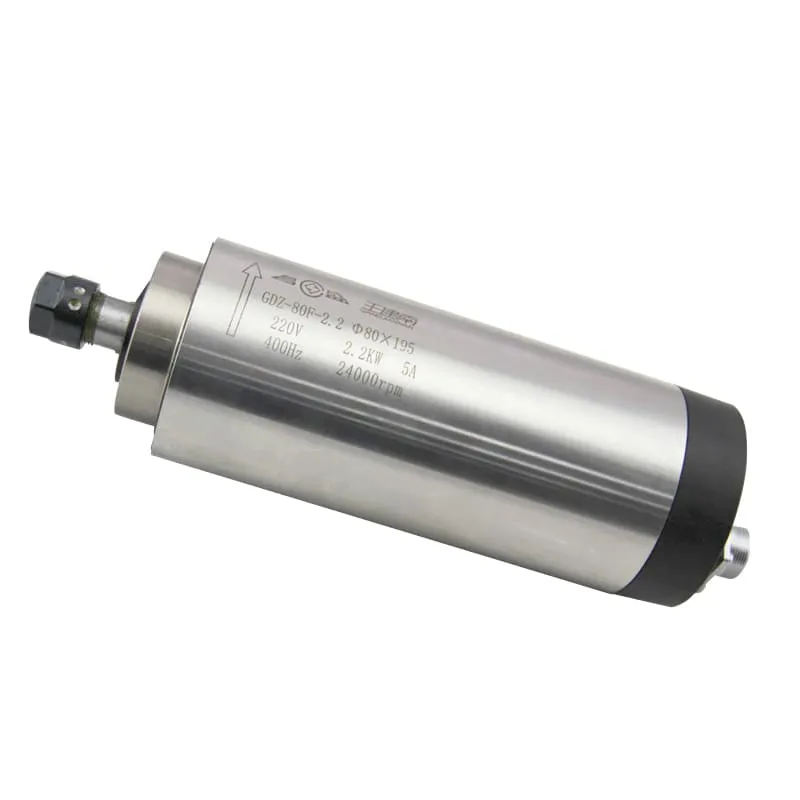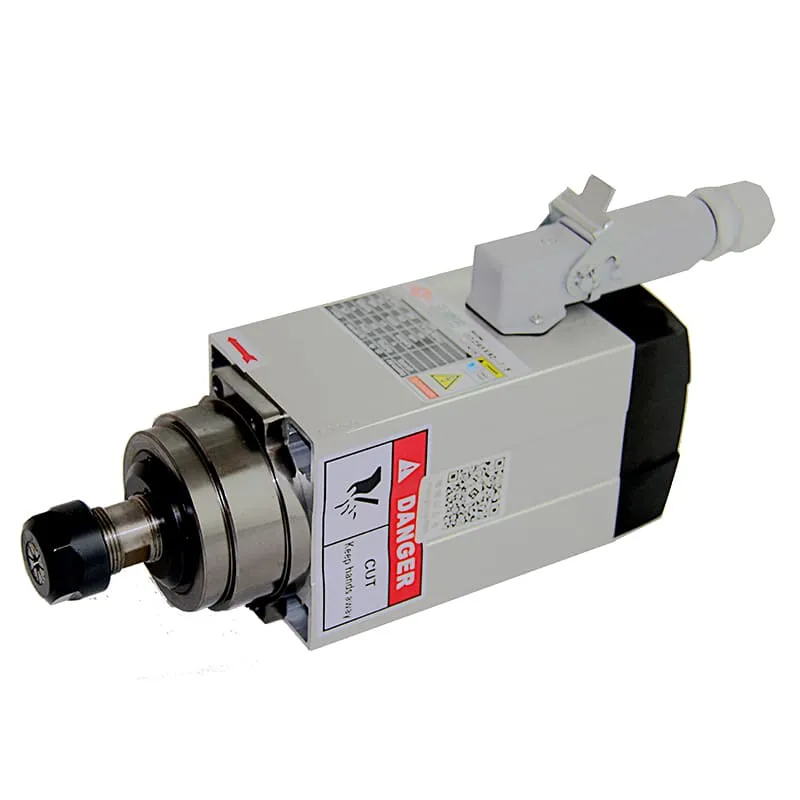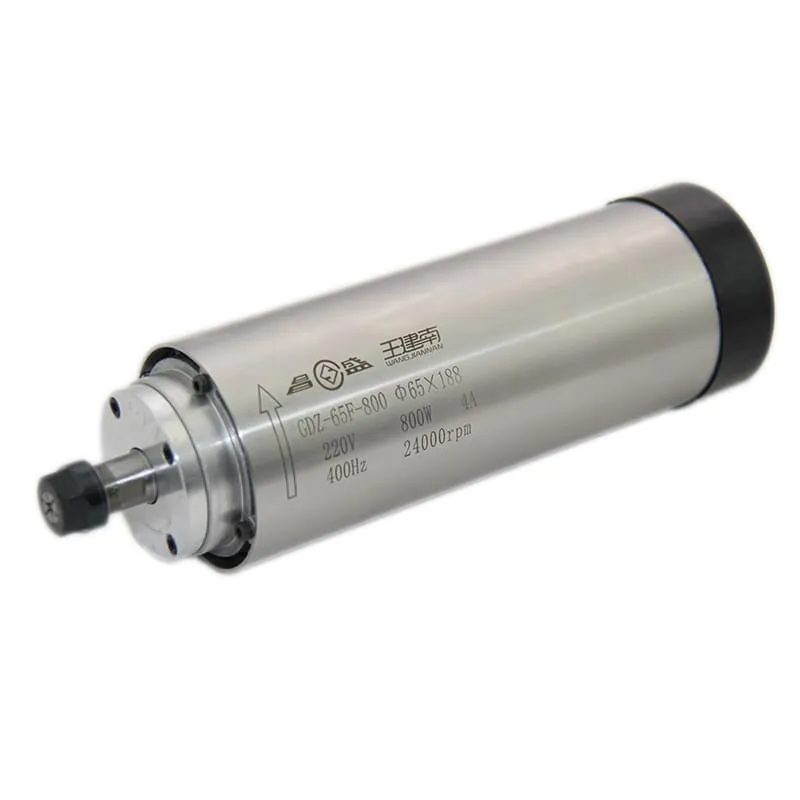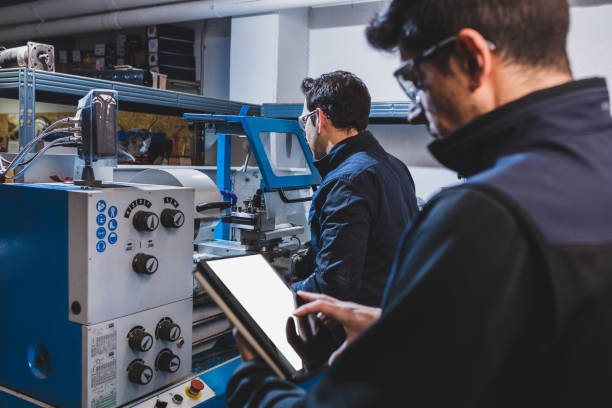How Loud is a CNC Machine?
CNC machines are powerful tools that have revolutionized manufacturing processes across various industries. However, one common concern for both operators and shop owners is the noise level these machines produce. Understanding how loud a CNC machine is can help in creating a safer and more comfortable work environment. Let’s dive into the details of CNC machine noise levels and explore ways to manage them effectively.
Understanding CNC Machine Noise Levels
CNC machines can generate significant noise during operation, typically ranging from 70 to 100 decibels (dB). To put this into perspective, normal conversation occurs at about 60 dB, while a loud rock concert can reach 120 dB. Prolonged exposure to noise levels above 85 dB can potentially cause hearing damage, making it crucial to address the noise output of CNC machines in any workshop or manufacturing environment.

The 2.2KW ER16 Air-Cooled Spindle is an example of a spindle that balances performance with noise considerations.
Factors Affecting CNC Machine Noise
Several factors contribute to the noise level of a CNC machine:
- Machine Type and Size: Larger machines tend to produce more noise due to their bigger motors and moving parts.
- Cutting Parameters: Higher spindle speeds and feed rates generally result in increased noise levels.
- Material Being Machined: Harder materials often require more aggressive cutting, leading to louder operations.
- Tool Selection: The type and condition of cutting tools can significantly impact noise production.
- Machine Maintenance: Well-maintained machines typically operate more quietly than poorly maintained ones.
- Environmental Factors: The acoustic properties of the workspace can amplify or dampen machine noise.
Comparing Noise Levels of Different CNC Machines
To give you a clearer picture, let’s compare the typical noise levels of various CNC machines:
| Machine Type | Approximate Noise Level (dB) |
|---|---|
| Desktop CNC Router | 70-80 dB |
| Small CNC Mill | 75-85 dB |
| Large Industrial CNC Machine | 85-100 dB |
| Water-cooled CNC Router | 65-75 dB |
It’s important to note that these are general ranges, and actual noise levels can vary based on specific models and operating conditions.
The Impact of Spindle Type on Noise Levels
The spindle is a crucial component that significantly affects the noise output of a CNC machine. Different types of spindles can produce varying levels of noise:
- Air-cooled Spindles: These tend to be louder due to the cooling fan.
- Water-cooled Spindles: Generally quieter as they don’t require a cooling fan.
- Belt-driven Spindles: Can be noisier due to belt vibrations.
- Direct-drive Spindles: Often quieter as they have fewer moving parts.

The 1.5KW ER11 Square Air-Cooled Spindle with Flange is a popular choice for those seeking a balance between performance and noise control.
Health and Safety Concerns Related to CNC Machine Noise
Prolonged exposure to high noise levels can lead to various health issues:
- Hearing Loss: The most direct consequence of excessive noise exposure.
- Stress and Fatigue: Constant loud noise can increase stress levels and cause fatigue.
- Reduced Concentration: High noise levels can impair focus and productivity.
- Cardiovascular Issues: Long-term exposure to loud noise has been linked to increased blood pressure.
Noise Reduction Techniques for CNC Machines
Reducing the noise level of your CNC machine can significantly improve the working environment. Here are some effective techniques:
- Enclosures: Building a sound-dampening enclosure around the CNC machine can dramatically reduce noise levels.
- Sound-absorbing Materials: Using materials like acoustic foam can help absorb and dampen sound.
- Vibration Isolation: Placing the machine on vibration-absorbing mats can reduce noise transmission.
- Optimizing Cutting Parameters: Fine-tuning your feed rates and cutting depths can minimize unnecessary noise.
- Regular Maintenance: Keeping your machine well-maintained can prevent excess noise from worn parts.
The Importance of Proper Machine Setup
A well-set up CNC machine not only performs better but also tends to be quieter. Ensure that:
- All bolts and fasteners are properly tightened
- The machine is level and stable
- Belts are correctly tensioned
- Bearings are in good condition and well-lubricated
Choosing the Right Tools for Noise Reduction
The tools you use can have a significant impact on noise levels. Consider:
- Using sharp, high-quality cutting tools
- Selecting tools with appropriate geometries for your material
- Employing noise-reducing tool holders

The 800W ER11 Air-Cooled Spindle is an excellent choice for those looking to minimize noise in smaller CNC setups.
The Role of CNC Controllers in Noise Management
Modern CNC controllers can play a crucial role in managing machine noise:
- Acceleration Control: Smooth acceleration and deceleration can reduce sudden noise spikes.
- Path Optimization: Efficient tool paths can minimize unnecessary movements and noise.
- Adaptive Feed Control: Adjusting feed rates based on cutting conditions can help maintain consistent noise levels.
Understanding Workplace Noise Regulations
It’s crucial to be aware of workplace noise regulations in your area. In many countries, there are strict guidelines regarding noise exposure:
- OSHA (USA) requires hearing protection for workers exposed to 85 dB over an 8-hour period.
- The EU Work Equipment Directive sets similar standards for European countries.
Always prioritize hearing protection and consider implementing a hearing conservation program if you work with CNC machines regularly.
The Future of Quiet CNC Machines
As technology advances, we’re seeing developments aimed at creating quieter CNC machines:
- Advanced Motor Technologies: New motor designs promise quieter operation.
- Improved Software Algorithms: Smarter tool path generation can reduce unnecessary noise.
- Novel Materials: New materials for machine construction may offer better sound dampening properties.
Case Studies: Successful Noise Reduction in CNC Workshops
Let’s look at a few real-world examples of successful noise reduction:
- A small woodworking shop reduced their CNC router noise from 95 dB to 75 dB by building a custom enclosure and upgrading to a water-cooled spindle.
- An industrial manufacturing facility decreased overall shop noise by 15 dB through a combination of machine enclosures, optimized cutting parameters, and regular maintenance schedules.
The Psychological Impact of CNC Machine Noise
It’s important to consider not just the physical effects of noise, but also the psychological impact:
- Constant loud noise can lead to stress and fatigue
- It may affect concentration and productivity
- In extreme cases, it could contribute to workplace dissatisfaction
Addressing noise concerns can lead to a more pleasant and productive work environment.
Balancing Noise Reduction with Machine Performance
While reducing noise is important, it’s crucial to maintain machine performance. Some noise reduction methods might impact cutting speed or precision. Always test any noise reduction measures to ensure they don’t negatively affect your work quality or efficiency.
The Economic Benefits of Noise Reduction
Investing in noise reduction can have significant economic benefits:
- Improved worker productivity due to a more comfortable environment
- Reduced risk of workplace accidents caused by communication difficulties in noisy settings
- Lower likelihood of worker compensation claims related to hearing damage
- Potential energy savings from more efficient machine operation
FAQs
1. How can I measure the noise level of my CNC machine?
You can use a decibel meter or smartphone app to get an approximate measurement of your machine’s noise level. For more accurate results, consider hiring a professional to conduct a thorough noise assessment.
2. Will using a water-cooled spindle significantly reduce my CNC machine’s noise?
Water-cooled spindles are generally quieter than air-cooled ones, as they don’t require a cooling fan. However, the actual noise reduction will depend on various factors, including the specific spindle model and your machine’s overall design.
3. Is it possible to make a CNC machine completely silent?
While it’s not possible to make a CNC machine completely silent due to the nature of its operation, significant noise reduction can be achieved through various methods like enclosures, proper maintenance, and optimized cutting parameters.
4. How often should I perform maintenance to keep my CNC machine running quietly?
Regular maintenance is key to keeping noise levels down. Perform basic checks daily, more thorough inspections weekly, and comprehensive maintenance monthly or as recommended by your machine’s manufacturer.
5. Can changing the type of CNC router bits affect the noise level?
Yes, the type and quality of router bits can impact noise levels. High-quality, sharp bits typically produce less noise. Additionally, bits designed for specific materials or with noise-reducing features can help lower overall machine noise.
Conclusion
Understanding and managing the noise levels of CNC machines is crucial for creating a safe, comfortable, and productive working environment. While CNC machines can be loud, ranging from 70 to 100 dB, there are numerous strategies to reduce noise levels. From choosing the right spindle and tools to implementing proper maintenance and noise reduction techniques, you can significantly improve your CNC machine’s acoustic profile.
Remember, addressing noise concerns not only protects your hearing but also enhances productivity and job satisfaction. As technology continues to advance, we can look forward to even quieter and more efficient CNC machines in the future. Whether you’re a hobbyist working in your garage or a professional in a large manufacturing facility, taking steps to manage CNC machine noise will lead to a better working experience for everyone involved.
By implementing the strategies discussed in this article, you can create a quieter, more pleasant CNC working environment without sacrificing performance. If you have any further questions about CNC spindles or noise reduction techniques, don’t hesitate to reach out to experts in the field.

